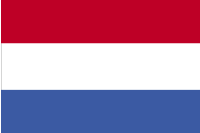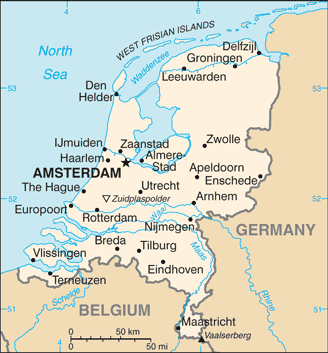Sep 4 2012
Topics Covered
Welcome to Netherlands
Overview of Resources
Industrial Minerals
Metals
Fossil Fuels
Investment
Sources
Welcome to Netherlands
Netherlands, with a total population of 16,730,632 as of July 2012, is located in Western Europe, bordering the North Sea, between Belgium and Germany. The country mostly has a temperate climate and covers a total area of 41,543 km2.
Netherlands as a kingdom was formed in 1815 after being occupied by the French for 20 years. The country’s economy stands out as the fifth largest economy in the euro-zone and it well known for its sizable trade surplus, moderate inflation and stable industrial relations. Netherlands industrial trade focuses mostly on petroleum refining, chemicals, electrical machinery and processing of food.
 |
The national flag of Netherlands.
Image Credit: CIA Factbook. |
Netherlands is considered as one of the European Union’s leading centers of industry and trade. The country’s economy, according to a 2010 survey, was of immense international focus and the Port of Rotterdam was considered the busiest port in Europe based on the volume and value of the cargo dealt with at the port.
The country’s economy experienced a steady growth for 26 years and in 2009 the economy drifted down due to the global recession. In view with this financial crisis the government introduced a number of measures to uplift the country’s economic status. Netherlands’ GDP as of 2011 was $713.1 billion.
Overview of Resources
In 2010, Netherlands continued to establish itself as a chief regional producer of petroleum and natural gas for the European market. The country was also a significant transshipment center for mineral products in Europe. Netherlands is regarded as the European Union’s fourth largest exporting country and it ranks seventh among other EU countries in terms of GDP based on purchasing power parity.
The country in 2010 was a chief producer of salt and nitrogen besides producing mineral products and nonmetallic and metallic minerals. On the whole, the country’s mineral industry focused a lot on trade and processing.
Industrial Minerals
In 2010, mining operations in Netherlands mainly focused on the extraction of sand and gravel, peat and limestone. However, the entire mineral industry is dwarfed by the production of petroleum and natural gas.

The map of Netherlands. Image Credit: CIA Factbook.
Metals
Iron and zinc are the chief metals produced by Netherlands. In 2010, the production of pig iron increased by 26%.
The production of zinc by Nyrstar in 2010 amounted to 1.076 Mt. Zinc production was carried out in the smelter at Budel.
Fossil Fuels
A recent oil and gas study highlighted Netherlands as the largest natural gas producer in the European Union. The Groningen field in Netherlands is one among the 10 largest gas fields in the world. The country also has a limited number of oil reserves and a number of small gas fields.
Production of natural gas at the Gessbrug gasfield increased in 2010, as a result of drilling an increasing number of production wells in the Gessbrug gasfield that is 11 to 15 times the size of the Grollo field.
In 2010, Vitol Tank Terminals B.V. announced its plans to expand the storage capacity of petroleum in its Rotterdam terminal to more than 1 million m3 along with access to truck-loading, barge jetty and rail facilities.
Investment
Being the largest natural gas producer in the European Union, Netherlands hopes to attract a lot more investments through exports of natural gas in order to improve its economic status. Experts feel that the country is becoming a leading distribution centre of natural gas in Europe.
Netherlands also plans to develop its mineral industry by concentrating more on its mineral processing activities that include the production of aluminium and cement.
Netherlands intends to continue its export of natural gas through the Port of Rotterdam that plays a significant role in the European export and import market. With this steady trade, the Port of Rotterdam will thus continue to establish itself as a leading European port especially with reference to container traffic.
Thanks to these ambitious plans, the country’s natural gas and mineral processing sector is likely to flourish in the future. According to experts, private and public investments towards the development of natural gas fields and the export of natural gas will be of immense importance in uplifting Netherlands’ economic status in the coming years.
Disclaimer: The Author of this article does not imply any investment recommendation and some content is speculative in nature. The Author is not affiliated in any way with any companies mentioned and all statistical information is publically available.
Sources